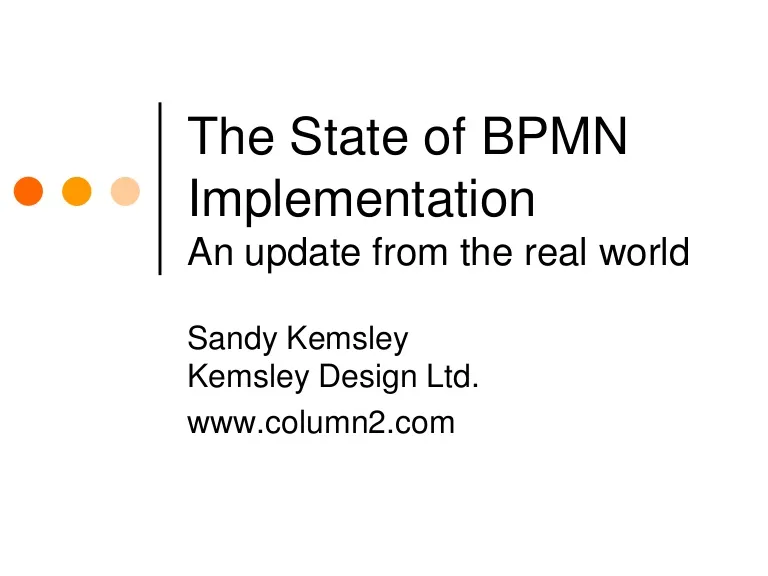BPMN In The Real World
Description
My presentation about how BPMN and process modeling are being used in the real world, on a webinar hosted by Active Endpoints.
Transcript
The State of BPMN ImplementationAn update from the real world
Sandy KemsleyKemsley Design Ltd.
www.column2.com
BPMN 2.0 Notation Update
New task types (good)
Data models (finally)
New event types (confusing)
Subclasses (helps with the confusion)
New interaction models (yikes)
plus
Metamodel and interchange format
BPMN Is Simple...
Activity
Gateway
Event
Data
Source: http://bpmb.de/poster
COMPLETE
Plus 50 elements
DODAF
Plus 29 elements
DESCRIPTIVE
Pool
Lane
messageFlow
userTask
serviceTask
Re-Usable subProcess
dataObject
dataInput
dataOutput
textAnnotation
Association
dataAssociation
dataStore
messageStartEvent
messageEndEvent
timerStartEvent
terminateEndEvent
SIMPLE
sequenceFlow
Task (none)
subProcess(embed)
exclusiveGateway
parallelGateway
startEvent (none)
endEvent (none)
BPMN Subclasses
Source: Workflow Management Coalition’s “Update on BPMN Release 2.0”
Learning About BPMN 2.0
Bruce Silver’s BPMN 2.0 posts: http://www.brsilver.com/wordpress/tag/bpmn-20/
BPMN 2.0 update webinar: http://bpm.acrobat.com/p83899988/
OMG standards document: http://www.omg.org/spec/BPMN/2.0/(not for the faint of heart)
How Are Process Models Created?
On paper/whiteboards/Post-Its
In PowerPoint/Word/Excel
In Visio (unstructured)
In Visio with BPMN template
In EA/BPA tool
In BPMS tool
Who Is Creating Process Models?
End users
Business managers
Business analysts
Process analysts
Process engineers
System analysts
Developers
What’s Wrong With Our Process Models?
Inconsistent/nonsensical notation
Ambiguity, especially split/merge
Improper use of roles
Too many words
Inappropriate tools
Just plain wrong
Process ModelHall of Shame
Sorry, redacted
Doing BPMN Right
Case study: Human Resources and Skills Development Canada
Getting started:
Process modeling for governance, not execution
Selected BPMN over IDEF and UML for business focus
Simulated processes to convince financial management of value
BPMN at HRSDC
Internal methodology for process modeling and BPMN
Using BPA tool for modeling and publishing
Internal BPMN training of ~140 people
Simulation training of ~3 people
Using desktop sharing software for mentoring
HRSDC BPMN Diagram
What Can Go Wrong
No formal recognition of process modeling as a discipline
No process modeling methodology
Lack of aptitude and/or training
Lack of mentoring
IT taking complete ownership of process modeling
What Makes BPMN Work
Overcome “belief gap” to convince people of benefits
Develop a methodology to accompany the notation
Identify people with aptitude/interest
Train different personas on different BPMN subclasses
Maintain BPMN guru for mentoring
